
Dock of the Bay

Volume VII Number 26
July 1-7, 1999
Eagles Soar on Independence Day
A pair of young eagles that set up temporary housekeeping
in a loblolly pine in Churchton last year didn't return for spring cleaning
this season. But on the Fourth of July, the U.S. Fish and Wildlife Service
says it plans to take the bald eagle o ff
the Endangered
ff
the Endangered
Species List, proof that the species is healthy, growing and recovered.
The eagle population had plummeted due to the effects of the pesticide DDT. In the 1960s and '70s, eagles had nearly disappeared in most states but Alaska. After DDT was banned in 1972, eagles have rebounded from only 417 breeding pairs in 1963. Today nearly 6,000 pairs breed in the lower 48 states. The recovery of our national symbol is proof that where there's an environmental will, there's a way.
In Maryland, bald eagle numbers soar, matching the national gain. A record number of nesting pairs were counted during the state's 1999 nesting survey. "This year's count of 260 nesting pairs exceeded the previous record of 232 nesting pairs set last year," Maryland Department of Natural Resources reported.
Only 41 nesting pairs of bald eagles were found in Maryland in 1977, the first year DNR surveyed nesting places. Now, 22 years later, "the bald eagle nesting population is six times greater," says DNR's eagle biologist Glenn Therres.
Most nesting sites are near tidal waters of the Bay and its major tributaries, DNR notes.
On the Fourth of July, our national bird will fly off the endangered list. But none of us - avian or human - is home free, and what we do in the next few years will determine whether eagles continue to prosper. Development is the danger.
"If current development trends continue on shoreline Chesapeake Bay property, eagles might be reduced by having no place to nest. The population will again start declining and breeding capacity top out," Therres cautions.
If you've wondered just how smart Maryland's Smart Growth policy is, here's your eagle-friendly answer:
"With its Smart Growth and Rural Legacy," Therres says, "Maryland has programs in place to offset sprawl."
We'd best make them work. Otherwise, 20 years down the road, we'll be re-enrolling our national bird on our national endangered list.
-M.L. Faunce
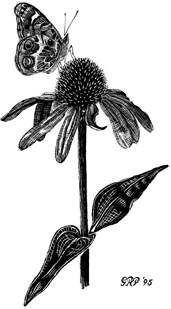
In Season:
Painted Lady and Purple Coneflower
by Gary Pendleton
You see a lot of purple coneflower, also known as echinacea, these days, not just in gardens but also in pharmacies, magazine ads and articles.
The roots are considered by many to have medicinal qualities. In The Green Pharmacy, Dr. James Duke recommends echinacea as an effective immune system booster for many ills from colds and flu to more serious diseases.
The plant, native to Midwestern prairies, can be grown from seed in a sunny location but probably won't come to flower until the second year. Ready-to-bloom plants are sold at nurseries. The flowers are colorful and interesting. They make excellent cut or dried flowers, and butterflies like them.
The American painted lady migrates in early summer to the Mid-Atlantic, where it prefers open areas such as meadows or yards with flowers such as purple coneflower.
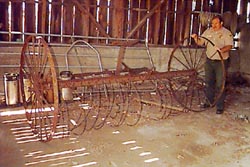
Farming was both the way and the means for most who lived in Anne Arundel and Calvert counties for hundreds of years. Now, telling the difference between a hayrake and a corn picker is a chore for many of us who drive past the few remaining farms on the way to big city jobs.
You'll learn what you're missing at 228-acre Kinder Farm Park, the newest addition to Anne Arundel County's 115-park, 6,000-acre system.
Kinder Farm Park in Millersville is becoming an agricultural history museum, a place where visitors can look back over the years at farming life. Farm equipment will be on display and working demonstrations will bring life to this history.
"If you don't protect these things and think about them, they'll be lost, just like if people who own Renoirs and Manets kept them to themselves, we would never see them," said Peggy Eversfield, of Fairhaven, who donated some of the old tools.
Donations poured into Kinder Farm Park from community supporters. The park received scythes, tractors, corn pickers and much more within a matter of weeks. Park superintendent Bill Offutt said he still receives phone calls from residents wanting to help.
Once the museum is open, some three years down the road, Offutt hopes to add livestock for visitors whose closest animals contacts are dogs and cats. He wants to show people cows and pigs as well as the way they contributed to farm life.
The park holds other growing treasures. In the community garden program,
would-be gardeners get their hands dirty. This opportunity was quickly snatched
up as all 90 plots - 20 feet by 30 feet - were sold.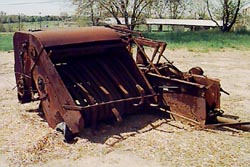
"This gives people who don't have the land of suitable growing conditions the opportunity to grow vegetables for themselves," Offutt said.
Now, the history project is waiting for grants to continue. But don't wait to visit, Offutt advises.
Old pasture areas - home to all sorts of wildlife - are the fastest disappearing ecosystems, Offutt says. Here, seven acres of warm season grasses and native wildflowers line the park. Tree seedlings were planted to increase the trees on the old farmstead. They'll compete with such giants as the largest river birch and the seventh largest black oak in the state.
That's not all the park has to offer. A half-acre playground entices children to work off energy on a hot, summer day. An amphitheater under construction will bring music to the park and host festivals and special attractions.
Kinder Farm Park and the four surrounding communities - Kilmarnock, Richards Overlook, Kinder Overlook and Chartwell - comprise the original Kinder family homestead. At the turn of the century, the Kinders owned 1,100 acres and worked the land until World War II, growing vegetables, other row crops and raising dairy cattle.
When the war ended, the Kinders dealt only in beef cattle. As time passed, land was subdivided into today's adjoining communities. The Kinder brothers sold the remaining 288 family-owned acres to Anne Arundel County in 1979, with the intention of creating a park.
"The motivation to purchase at the time was because of development in the county. There was getting to be a scarcity of large parcels of land," said Jack Keene of the Anne Arundel County Department of Recreation and Parks.
"In the northern part of the county, the agricultural history was disappearing under development," Keene added.
But now, Kinder Farm Park is resurrecting the now paved-over heritage of Anne Arundel County.
-Mary Catherine Ball
Life in Our
Little Bay Ponds
In Calvert, Women Voters Survey Their Gains
photo by Carol Glover Calvert County's League of Women Voters celebrated 30 years
of working together.
"Inform voters; advocate good government."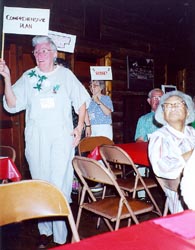
These five words explain the League of Women Voters of Calvert County. Women working together are a force to be reckoned with, and the force has been with Calvert County for 30 years, since 1969, when the League of Women Voters of the United States recognized The League of Women Voters of Calvert County.
Calvert's members, 123 strong, celebrated their 30th anniversary with Calvert County Commissioner Pat Buehler, State Sen. Roy Dyson, Board of Education member Ruth Keimig and guests at a potluck picnic at Scientists Cliffs Community Center. The League's women and men, known for their culinary as well as their intellectual expertise, put on quite a feast.
During this informal evening of celebration, members paraded around the room with signs identifying the major issues studied during these past 30 years. Past presidents reminisced about their years in office, bringing these accomplishments to life.
From the 1970s, Whitehall Clevenger, president 1974-75, explained, "My mother was a member; I'm second generation. Sponsoring the first Calvert Meet the Candidates Night and our study on the charter form of government are two of my proudest accomplishments."
The need for public housing, documented by the League in the 1970s, led to the formation of Calvert's housing authority. During that active decade, the League attracted 90 members to its fold.
From the 1980s, Eleanor Prince, president 1981-83, recalled Government Day. "The courthouse was open, you could visit different departments, there were displays and music. I think it might be a good idea to do this again, maybe once every five years."
The League's transportation study during the 1980s resulted in the hiring of a transportation official, albeit 10 long years later. Local health and mental health issues led to the formation of the Mental Health Association and Calvert's Hospice. Ever aware of the importance of history, in 1983 the League helped restore the Old Polling Place in St. Leonard.
The 1990s brought renewed energy and activity to the League. Gracie Rymer, president 1991-93, recalled the League's transportation study, our water study, motor voter and a national candidate's night.
The League's study on children and families in Calvert and the publication of its study, "Children at Risk, A Wake-up Call for Calvert County" resulted in the creation of Calvert Crusade for Children.
Wearing a beautiful Zambian cloth as a sarong, Marie Andrews, president 1997-'99, recalled the '90s project with Zambia. "We brought Moosho and Josephine [two Zambian women] here to study how democracy works at the grassroots level," she said. The exchange continues this summer when two of Calvert's members study new lessons in Zambia.
President Marlyn Kefauver brings the League into the 21st century with plans to revisit the charter form of government, hold a fall town meeting and study charter schools and school vouchers.
The accomplishments of three decades rise far above these highlights. Barbara Fetterhoff, 1995-97 president, plans to publish a history of the League. Tentatively titled, "A League of Their Own," it will include all the League's studies and publications for a truer picture of the League's impact on Calvert's government structure and the county's everyday life.
Baker Hinchliffe, with the League since 1967 as a charter member, sums up the League's work: "Good things have come out of our studies. We have the respect of the commissioners. They have found that what we say is true."
-Carol Glover
Music to Our Ears: Historic
Hartge Pianos Reappear
photos by M.L. Faunce Only three of the pianos crafted more than 150 years ago
by German immigrant Heinrich Hartge are known to survive.
On the Western shore of the Chesapeake Bay, the
family name of Hartge has long been linked to boat design and building.
But the skilled family that turned out working boats and sailing yachts
also turned out finely tuned and crafted pianos a century and a half ago.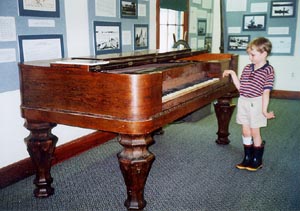
Only three Hartge pianos - made in either Baltimore or Shady Side in the mid-1800s - are known to exist today. That they exist at all is something near a miracle.
When Anton Heinrich Hartje (1791-1858) emigrated from Germany to America in 1832, he brought the old ways with him. His craftsmanship as a cabinet maker and piano manufacturer helped him earn enough money to bring his wife and four children to Baltimore, where he prospered making pianos for well to do Marylanders.
Traveling to those customers in the southern part of Maryland to deliver or tune his pianos is how Henry Hartge (his Anglicized name) came to discover Shady Side, a peninsula then reached only by water. "He visited Shady Side and fell in love with the area," great grandson Laurence said.
Henry Hartge enjoyed hunting in the woods well stocked with birds and game. In 1840, "He bought what would be all of West Shady Side today: "All the land lying along the West River from Cedar Point to South Creek."
Hartge established a piano factory at Mill Point in Shady Side at the end of Steamboat Road. To this isolated rural enclave, Hartge and his wife Louisa, "added a new dimension to life in the community, for they brought with them skills and talents acquired in Europe," wrote Virginia White Fitz in her book, Spirit of Shady Side.
Of the three original Hartge "rectangular grand" pianos built during the late 1830s or early 1840s and known to exist today, two are now on public display.
Great grandson Robert Hartge of Galesville pushed to get one of the pianos
on loan to the Shady Side Rural Heritage Society. "It had been in storage
for years, and it was silly to keep it in storage," he said.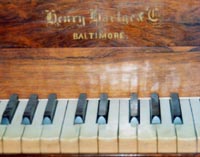
The rosewood rectangular grand piano, about three feet wide and six feet long and set on blocky sculpted legs in a sturdy Germanic stance, is now on "indefinite loan" at the Society's Captain Salem Avery Museum in Shady Side.
This piano may not have survived into another millennium had it not been for a sharp-eyed Galesville fireman who spied the antique piece when fighting a fire that broke out in the home of a Captain Walsh in Harwood back in the early 1950s.
The piano, bearing the nameplate "Henry Hartge, Baltimore," was saved from destruction. No one seems to remember that the Naval Academy coach's house on Fiddler's Hill Road burned down.
A second Hartge piano traveled farther before coming to rest at the new Hartge Nautical Museum in Galesville.
"A friend called me and said he had read an ad in an automobile magazine for a piano for sale that fit the Hartge piano description," Robert Hartge told NBT. "My sister, Elsie Hartge Wallis [who owns the third piano] and I debated who should buy it, and I just said, 'it doesn't matter who buys it. We just need to get it back.'"
Someone had taken the piano to Florida and was moving there when their car broke down. They left it at a filling station and there it sat for 10 years, until it was put on sale. That was about 15 years ago," Robert Hartge remembered. That piano has been in storage here ever since.
Both pianos appear to be in good condition, but neither has been restored or tuned, an expensive proposition for antique sounding boards now a century and a half old. The pianos may resonate with the sound of a quieter, gentler past, but today that's music only for the imagination.
After the Civil War, the economy changed and demand fell off for pianos then being made by two of Henry Hartge's sons. When Emile Hartge bought land across the West River in Galesville, another family tradition - boat-building - was born of Henry Hartge's skills.
The Hartges hope to learn more about the family pianos. Share your knowledge with New Bay Times or either museum.
-M.L. Faunce
Virginia suffered its worst air pollution in history last year, two advocacy groups reported last week. The Southern Environmental Law Center and the Izaak Walton League reported that air was so bad in Shenandoah National Park on some days that hikers seeking to get away from it all suffered ...
Cleveland is known as home of the Indians, to the Rock 'n' Roll Hall of Fame and to the Cuyahoga River, which was so polluted it caught fire 30 years ago. Last week, a park was opened to celebrate a massive clean-up that finally has restored the Cuyahoga for people to use ...
In Canada, genetic scientists have engineered an animal that they hope will counter all the negative publicity about genetic tinkering. His name is Enviropig, and he's so named because his manure contains less phosphorous, one of the nutrient pollutants that chokes rivers and streams ...
In Mozambique, the discovery of a Barbary lion in a circus sparked an investigation that has found more of the rare lions in zoos and circuses, the New York Times reported this week. The last Barbary (think MGM lion) in the wild was shot in Morocco in 1921 ...
Our Creature Feature comes to us from Connecticut, where a news item last week suggested a new twist on the old joke about stopping at the Road Kill Cafe.
The Denison Pequotsepos Nature Center in the town of New London has issued a request for the public for "road kill in good condition." That means dead skunks, woodchucks, rabbits and even hapless possums that encounter auto tires.
What for, you ask? The center is stuffing creatures for its new meadow exhibit. They already have strange road kill, like weasels and star-nosed moles. But, lamented the center's director, "People don't bring us the ordinary stuff."
| Issue 26 |
Volume VII Number 26
July 1-7, 1999
New Bay Times
| Homepage |
| Back to Archives |